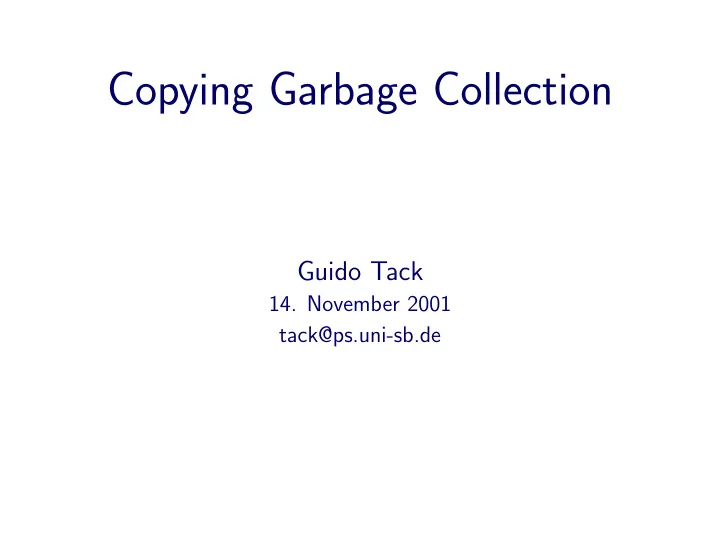

7 Properties • Constant stack required • Time depends only on no. of live nodes • Covers cycles / sharing • Heap is compacted • Stop/start collector • Nothing to do between GCs
7 Properties • Constant stack required • Time depends only on no. of live nodes • Covers cycles / sharing • Heap is compacted • Stop/start collector • Nothing to do between GCs
7 Properties • Constant stack required • Time depends only on no. of live nodes • Covers cycles / sharing • Heap is compacted • Stop/start collector • Nothing to do between GCs
7 Properties • Constant stack required • Time depends only on no. of live nodes • Covers cycles / sharing • Heap is compacted • Stop/start collector • Nothing to do between GCs
7 Properties • Constant stack required • Time depends only on no. of live nodes • Covers cycles / sharing • Heap is compacted • Stop/start collector • Nothing to do between GCs
8 Disadvantages High Level • Copying large objects is expensive • Twice the logical memory needed Low Level • Breadth first ⇒ decreased locality • Paging issues
8 Disadvantages High Level • Copying large objects is expensive • Twice the logical memory needed Low Level • Breadth first ⇒ decreased locality • Paging issues
8 Disadvantages High Level • Copying large objects is expensive • Twice the logical memory needed Low Level • Breadth first ⇒ decreased locality • Paging issues
8 Disadvantages High Level • Copying large objects is expensive • Twice the logical memory needed Low Level • Breadth first ⇒ decreased locality • Paging issues
8 Disadvantages High Level • Copying large objects is expensive • Twice the logical memory needed Low Level • Breadth first ⇒ decreased locality • Paging issues
9 Variations(1) • Large Object Areas (possibly handled by different collector) • Areas for long living objects (only scanned, not copied) • Maintain locality by using other exploration strategies (but then stack becomes an issue)
9 Variations(1) • Large Object Areas (possibly handled by different collector) • Areas for long living objects (only scanned, not copied) • Maintain locality by using other exploration strategies (but then stack becomes an issue)
9 Variations(1) • Large Object Areas (possibly handled by different collector) • Areas for long living objects (only scanned, not copied) • Maintain locality by using other exploration strategies (but then stack becomes an issue)
9 Variations(1) • Large Object Areas (possibly handled by different collector) • Areas for long living objects (only scanned, not copied) • Maintain locality by using other exploration strategies (but then stack becomes an issue)
9 Variations(1) • Large Object Areas (possibly handled by different collector) • Areas for long living objects (only scanned, not copied) • Maintain locality by using other exploration strategies (but then stack becomes an issue)
9 Variations(1) • Large Object Areas (possibly handled by different collector) • Areas for long living objects (only scanned, not copied) • Maintain locality by using other exploration strategies (but then stack becomes an issue)
9 Variations(1) • Large Object Areas (possibly handled by different collector) • Areas for long living objects (only scanned, not copied) • Maintain locality by using other exploration strategies (but then stack becomes an issue)
10 Variations(2) Approximately depth-first copying(1) Modification of Cheney’s agorithm by Moon (1984) • Always start scanning on the last partially filled page in To-space • When that page is completed, continue with ordinary scan • As soon as an object is copied, start partial scan again scan partial free
10 Variations(2) Approximately depth-first copying(1) Modification of Cheney’s agorithm by Moon (1984) • Always start scanning on the last partially filled page in To-space • When that page is completed, continue with ordinary scan • As soon as an object is copied, start partial scan again scan partial free
10 Variations(2) Approximately depth-first copying(1) Modification of Cheney’s agorithm by Moon (1984) • Always start scanning on the last partially filled page in To-space • When that page is completed, continue with ordinary scan • As soon as an object is copied, start partial scan again scan partial free
10 Variations(2) Approximately depth-first copying(1) Modification of Cheney’s agorithm by Moon (1984) • Always start scanning on the last partially filled page in To-space • When that page is completed, continue with ordinary scan • As soon as an object is copied, start partial scan again scan partial free
10 Variations(2) Approximately depth-first copying(1) Modification of Cheney’s agorithm by Moon (1984) • Always start scanning on the last partially filled page in To-space • When that page is completed, continue with ordinary scan • As soon as an object is copied, start partial scan again scan partial free
11 Variations(3) Approximately depth-first copying(2) • Drawback: Some nodes are scanned twice • Tests indicate a 15 percent improvement of locality • . . . and a 6 percent increased GC time
11 Variations(3) Approximately depth-first copying(2) • Drawback: Some nodes are scanned twice • Tests indicate a 15 percent improvement of locality • . . . and a 6 percent increased GC time
11 Variations(3) Approximately depth-first copying(2) • Drawback: Some nodes are scanned twice • Tests indicate a 15 percent improvement of locality • . . . and a 6 percent increased GC time
Recommend
More recommend